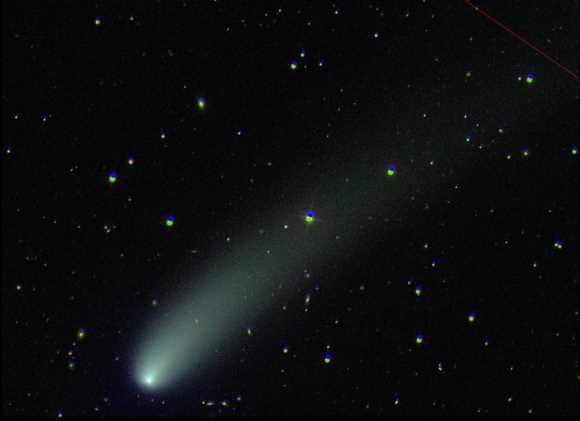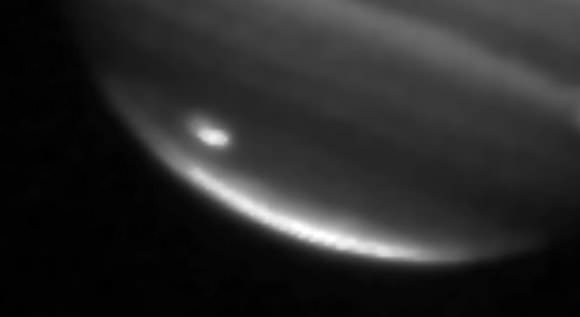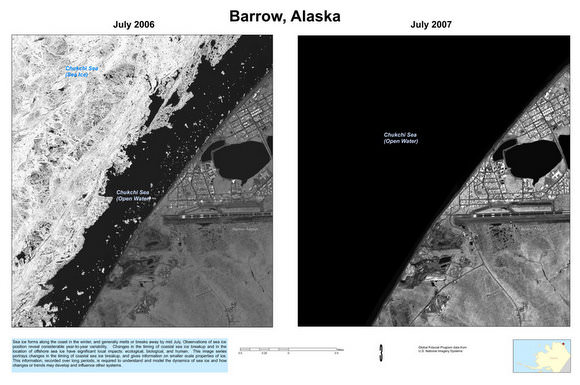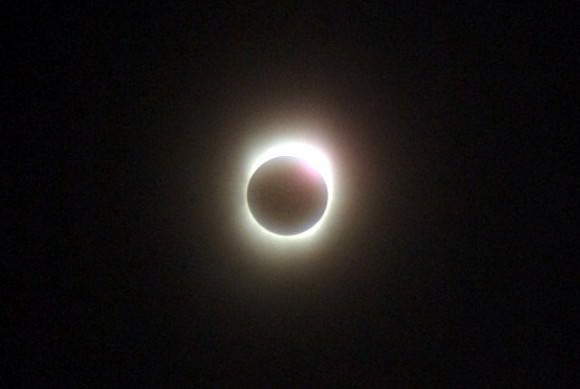Newly Discovered Cometary Route Sneaks Past Jupiter, but Decreas

Astronomers have used the comet record — including 2001 RX14 (Linear) at left, captured in 2002 by the Sloan Digital Sky Survey — to model a new route for incoming comets that sneaks past Jupiter's gravity.
The pathway might even be the dominant one that delivers Oort Could comets on an Earth-bound trajectory, say the authors of a new study in Science this week — but if that's true, comets only rarely cause extinctions on Earth.
(Image credit: Mike Solontoi/University of Washington)
(...)
Read the rest of Newly Discovered Cometary Route Sneaks Past Jupiter, but Decreases Risk of Earth Impacts (747 words)
NASA Science News for August 6, 2009
NASA's new planet-hunting Kepler space telescope has detected the changing phases and atmosphere of a planet a thousand light years away.
FULL STORY at
http://science.nasa.gov/headlines/y2009/06aug_kepler2.htm?list1035898
NASA Science News for August 3, 2009
Two weeks after something slammed into Jupiter, creating a cloud of debris that is still easy to see through backyard telescopes, researchers are wondering ... what was the impactor?
FULL STORY at
http://science.nasa.gov/headlines/y2009/03aug_whathitjupiter.htm?list1035898
NASA Science News for July 31, 2009
Earth is entering a stream of debris from Comet Swift-Tuttle, setting the stage for the 2009 Perseid meteor shower.
FULL STORY at
http://science.nasa.gov/headlines/y2009/31jul_perseids2009.htm?list1035898
Declassified Ice Loss Images
Last week the US government released more than a thousand intelligence images of Arctic ice that have been used to help scientists study the impact of climate change. The images were taken by spy satellites, as part of the Medea program, which lets scientists request spy pictures from environmentally sensitive locations around the world. After they were taken, the Bush Administration released the photographs to the scientists but deemed them "unsuitable for public release." Earlier this month, the National Academy of Sciences recommended the Obama Administration declassify the photos, which they did within a few hours of the recommendation.
Various blogs are saying these dramatic images are faked, but since they are available through the US Geological Survey , that hardly seems likely. Over 700 images show changes of sea ice in various recent years from six sites around the Arctic Ocean, with an additional 500 images of 22 sites in the United States.
(...)
Read the rest of Declassified Ice Loss Images (87 words)
Giant Soap Bubble In Space
What looks like a giant soap bubble or even perhaps just a water drop on a camera lens is actually a newly discovered planetary nebula. Dave Jurasevich of the Mount Wilson Observatory in California spotted the "Cygnus Bubble" while recording images of the region in July 2008. A few days later, amateur astronomers Mel Helm and Keith Quattrocchi also found it. Then, in 2009, the Kitt Peak Observatory pointed its 4-meter Mayall telescope at the object, and created the image above. Spectacular!
(...)
Read the rest of Giant Soap Bubble In Space (162 words)
Vixen R130Sf Newtonian Reflector Telescope and PortaMount II – R
So what's the latest telescope I've been testing? This time it's a Vixen R130Sf Newtonian Reflector Telescope and PortaMount II. I can tell you right now that I've never laid my hands on a telescope that I was more comfortable with out of the box than this one… But, I guess I really need to start the story from the beginning, don't I? Then follow me over to the Observatory and I'll tell you how this charming Vixen stole my heart away. (...)
Read the rest of Vixen R130Sf Newtonian Reflector Telescope and PortaMount II – Right In The Comfort Zone… (1,868 words)
Spitzer Finds a Cyclops Galaxy!

Imagine peering through your telescope and having a wild creature with one Cyclops-like eye looking back at you! NASA's Spitzer Space Telescope saw just that when it located galaxy NGC 1097, about 50 million light-years away. It has long, spindly arms of stars, and its one "eye" at the center of the galaxy is actually a monstrous black hole surrounded by a ring of stars. Plus, this creature looks to be carrying a smaller blue galaxy in its arms!
(...)
Read the rest of Spitzer Finds a Cyclops Galaxy! (378 words)
Happy 10th Birthday, Chandra X-Ray Observatory!
Ten years ago, on July 23, 1999, NASA's Chandra X-ray Observatory was deployed into orbit by the space shuttle Columbia. Far exceeding its intened 5-year life span, Chandra has demonstrated an unrivaled ability to create high-resolution X- ray images, and enabled astronomers to investigate phenomena as diverse as comets, black holes, dark matter and dark energy.
(...)
Read the rest of Happy 10th Birthday, Chandra X-Ray Observatory! (420 words)
July 22, 2009 Total Solar Eclipse – Incoming News…
The total solar eclipse which just occured on the 22nd of July 2009 was the longest in terms of maximum totality duration of the 21st century – lasting over six and a half minutes. Not since Saros 1991 have astronomers and eclipse chasers been treated to such a length of time! The eclipse footprint started in India along the western shore near Surat moved towards Butan and reached the southern tip of Nepal and the northern edge of Bangladesh. For other lucky astronomers, the eclipse path also took the event over the Chinese cities of Chengdu, Suining, Chonging, Wuhan, Xiaogan, Hangzhou, and Shanghai – yielding five minutes of totality. Leaving Shanghai the shadow raced across the ocean to fall across islands such as Toshima and Akusaki south of Japan and eventually the Marshall islands. Where did the longest time occur? The maximum eclipse duration of 6 minutes and 43 seconds was far off the coast in the Pacific Ocean! As I write this announcement, our readers are sending in their photos and stories to my home email (send them!!) and I just couldn't wait to show you some of the beginning results. It will take a short time to do a little translation work… But it's a small, wonderful world and this article will be updated very soon!
Astro Art of the Week: Space Travelers
Here's the second installment of our new feature, showcasing our readers' prowess with image editing software. This week's Astro Art of the Week was submitted by Laura Gardiner from Tucson, Arizona USA. This seemed to be a perfect image to use, as during Apollo 11 festivities on Monday, astronauts repeatedly talked about inspiring the next generation of space explorers. This is a collage Laura created several months ago with Photoshop, using several PS brushes downloaded from deviantart.com, along with a photo of her daughter and nephew. "I've gotten a lot of positive comments about it," she said. "I was new to Photoshop then, but I've been having fun learning new things. I probably would have done some things differently now, but all in all I think it turned out pretty neat. It was an experiment because I was fascinated by the idea of Photoshop's "brushes," so that's where the stars/galaxies/etc. came from. I didn't have any particular picture or project in mind when I made it…it just sort of came together after several hours of fooling around with stuff."
(...)
Read the rest of Astro Art of the Week: Space Travelers (105 words)
A Table-Top Test of General Relativity?

Even Albert Einstein might have been impressed. His theory of general relativity, which describes how the gravity of a massive object, such as a star, can curve space and time, has been used to predict small shifts in the orbit of Mercury, gravitational lensing by galaxies and black holes, and the existence of gravitational waves. Now, new research shows it may soon be possible to study the effects of general relativity in bench-top laboratory experiments.
(...)
Read the rest of A Table-Top Test of General Relativity? (680 words)
"Feelings" Are Back at NASA
Steely-eyed missile men may still be a part of NASA, but the space agency's newly sworn-in administrator says he is an unabashed hugger and admits to crying easily. "One more thing you'll learn about me, I cry," said Charlie Bolden at an all-hands video meeting with the NASA centers. "I think it's important to be passionate." Bolden's Deputy Administrator Lori Garver said she's a hugger, too and as Bolden and Garver hugged on stage, Garver exclaimed, "Feelings are not something that were popular in the last few years at NASA, but they're back. Feelings are back!"
(...)
Read the rest of "Feelings" Are Back at NASA (402 words)
Thirty-Meter Telescope Headed for Mauna Kea

The Thirty Meter Telescope, which is vying to be the inaugural member of an emerging class of giant eyes in the sky, is headed for the Mauna Kea in Hawaii.
That means the other contending site, Cerro Armazones in Chile, is off the drawing board.
(...)
Jupiter Impact Confirmed

As we reported yesterday, an amateur astronomer snapped evidence of an impact on Jupiter. Now, NASA has confirmed the black spot on the giant gas planet is in fact an impact and not just a weather-related disturbance. And Anthony Wesley has now made the biggest observation of his life.
"It still feels very surreal right now," he told Universe Today. "I guess it will take some time to really sink in (pun intended). I guess it shows that persistence and many hours at the scope eventually pays off."
(...)
Read the rest of Jupiter Impact Confirmed (525 words)






